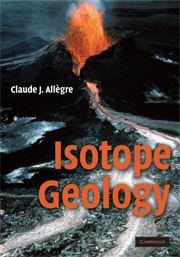Book contents
- Frontmatter
- Contents
- Preface
- Acknowledgments
- Isotopes and radioactivity
- The principles of radioactive dating
- Radiometric dating methods
- Cosmogenic isotopes
- Uncertainties and results of radiometric dating
- Radiogenic isotope geochemistry
- Stable isotope geochemistry
- Isotope geology and dynamic systems analysis
- References
- Appendix
- Further reading
- Solutions to problems
- Index of Names
- Subject Index
Stable isotope geochemistry
Published online by Cambridge University Press: 05 June 2012
- Frontmatter
- Contents
- Preface
- Acknowledgments
- Isotopes and radioactivity
- The principles of radioactive dating
- Radiometric dating methods
- Cosmogenic isotopes
- Uncertainties and results of radiometric dating
- Radiogenic isotope geochemistry
- Stable isotope geochemistry
- Isotope geology and dynamic systems analysis
- References
- Appendix
- Further reading
- Solutions to problems
- Index of Names
- Subject Index
Summary
When defining the properties of isotopes we invariably say that the isotopes of an element have the same chemical properties, because they have the same electron shell, but different physical properties, because they have different masses. However, if the behavior of isotopes of any chemical element is scrutinized very closely, small differences are noticeable: in the course of a chemical reaction as in the course of a physical process, isotope ratios vary and isotopic fractionation occurs. Such fractionation is very small, a few tenths or hundredths of 1%, and is only well marked for the light elements, let us say those whose atomic mass is less than 40. However, thanks to the extreme precision of modern measurement techniques, values can be measured for almost all of the chemical elements, even if they are extremely small for the heavy ones.
When we spoke of isotope geochemistry in the first part of this book, we voluntarily omitted such phenomena and concentrated on isotope variations related to radioactivity, which are preponderant. We now need to look into the subtle physical and chemical fractionation of stable isotopes, the use of which is extremely important in the earth sciences.
Identifying natural isotopic fractionation of light elements
The systematic study of the isotopic composition of light elements in the various naturally occurring compounds brings out variations which seem to comply with a purely naturalistic logic. These variations in isotope composition are extremely slight, and are generally expressed in a specific unit, the δ unit.
- Type
- Chapter
- Information
- Isotope Geology , pp. 358 - 435Publisher: Cambridge University PressPrint publication year: 2008



